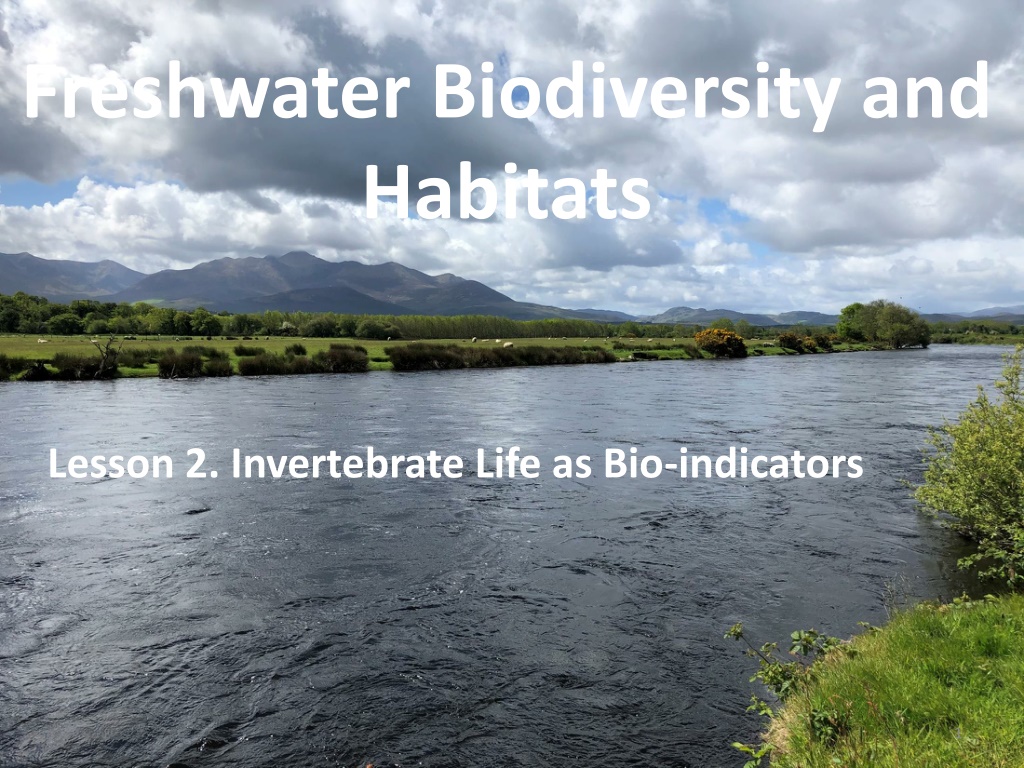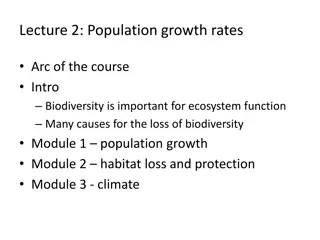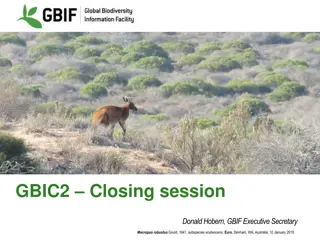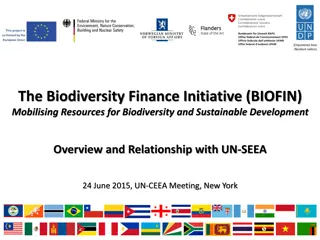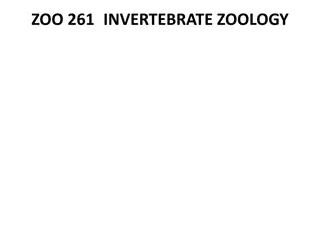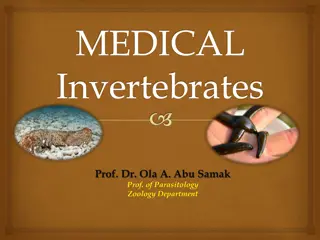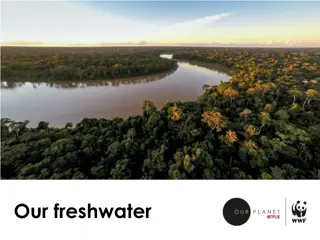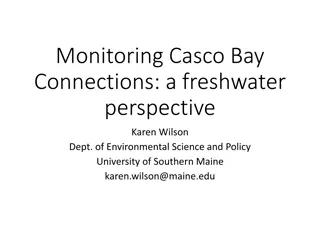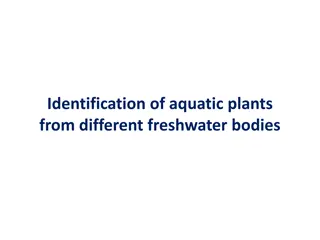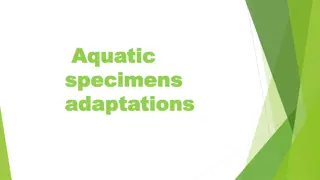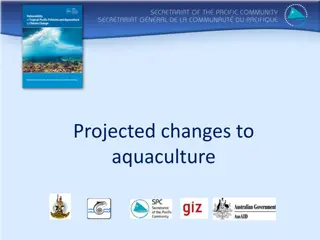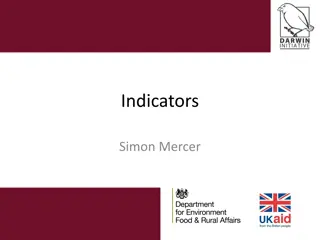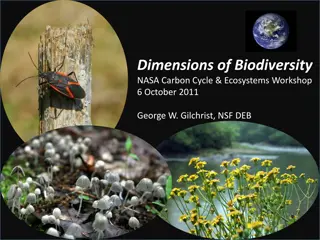Understanding Freshwater Biodiversity: Invertebrate Bio-indicators
Explore how invertebrates like stoneflies, mayflies, and caddisflies can be used as bio-indicators to determine water quality in freshwater habitats. Each species has specific environmental requirements, making their presence or absence a valuable tool for assessing the health of freshwater ecosystems.
Download Presentation

Please find below an Image/Link to download the presentation.
The content on the website is provided AS IS for your information and personal use only. It may not be sold, licensed, or shared on other websites without obtaining consent from the author. Download presentation by click this link. If you encounter any issues during the download, it is possible that the publisher has removed the file from their server.
E N D
Presentation Transcript
Freshwater Biodiversity and Habitats Lesson 2. Invertebrate Life as Bio-indicators 1
Nature Needs Good Water Quality Water quality describes the condition of the water, according to chemical, physical, and biological characteristics. In the same way humans need clean water so too does nature. Some invertebrates can only survive in very good water conditions. Over the next few slides, you will learn about these species and how we can use their presence or absence to tell us more about water quality. 2
Using invertebrates to determine water quality Stoneflies The EPA and County Council scientists use a method based on the kinds of invertebrates present in a river to determine the water quality. This is called the Quality Rating or Q System Mayflies Caddisflies Freshwater Shrimp Snails Q Value Water Quality Q5, Q4-5 Unpolluted Water louse Q4 Unpolluted Bloodworms Q3-4 Slightly Polluted Q3, Q2-3 Moderately Polluted 3 Q2,Q1-2 Seriously Polluted
Clean Water Fauna (animals) Stoneflies Insect family (3 pairs of legs) 20 different species in Ireland They have 2 tails Lives in fast-flowing water for 1-2 years. Most graze algae but some species are predators. Stonefly - Juvenile stage Stoneflies need lots of oxygen and generally live in faster-flowing water They eventually hatch into a flying adult. Their wings lie flat over their body. If the river is polluted by a pollutant that removes oxygen, they will die. Stonefly - Adult stage If you find stoneflies in a river, it means the water quality is very good - a good bio-indicator of high water quality. 4
Clean Water Fauna Mayflies Juvenile flathead mayfly Insect 33 different species in Ireland. Note the 3 tails and gills on the side of the body. Juvenile stage-lives in the river for 1-2 years. Adult mayfly Grazes on algae and plants. Some mayflies need lots of oxygen and live in faster-flowing water like the flathead mayflies. These are indicators of good water quality, i.e. bio-indicators. Others are not as fussy and be found in lightly polluted water. Hatches into a flying short-lived adult. Wings held upright like a sail.5
Clean Water Fauna Cased caddis Caddisflies Insect 156 different species in Ireland These are predators of other invertebrates Some build cases of stones or plant material as camouflage. Caseless caddis Others are caseless. Some spin a web like spiders to catch prey The adults are also known as sedge flies The caddis larva hatches into a flying adult that looks like a moth. Wings folded over the body like a tent. Caddis are very diverse. Some require good water quality, others are less demanding. 6
Polluted Water Fauna Freshwater shrimps Crustaceans Note-lots of legs and body segments! Shrimps can live in clean or even heavily polluted water. Snails Molluscs They are herbivores and are important as food for fish. Some types require clean water, while other types are less demanding If these are present and the clean water fauna are reduced or absent, it means the water is polluted.
Polluted Water Fauna Water Louse (Asellus) Crustacean Are an aquatic type of woodlouse They are scavengers and can tolerate the very low oxygen levels found in polluted rivers and lakes . If you find a lot them, you know the water is polluted. Bloodworm or chironomid These are not worms but are the larvae of an insect. Hatch into a small fly, like a mosquito. Red because they contain haemoglobin (usually not found in insects). This allows them to live in water that has very little oxygen. If you find a lot them, you know the water is polluted. 8 Task 2.1
Using invertebrates to determine water quality Stoneflies The EPA and County Council scientists use a method based on the kinds of invertebrates present in a river to determine the water quality. This is called the Quality Rating or Q System Mayflies Caddisflies Freshwater Shrimp Snails Q Value Water Quality Q5, Q4-5 Unpolluted Water louse Q4 Unpolluted Bloodworms Q3-4 Slightly Polluted Q3, Q2-3 Moderately Polluted 9 Q2,Q1-2 Seriously Polluted
Pollution of rivers is most frequently caused by organic matter on nutrient such as nitrogen and phosphorus. These pollutants reduce the amount of oxygen in the water. Organic Matter, N, P Stoneflies Mayflies Caddisflies Freshwater Shrimp Snails When oxygen levels in a river are reduced by pollution, the clean water fauna are replaced through competition with organisms that are better suited to lower oxygen levels. Water louse Bloodworms O2
How do find the water quality or Q value of a river? Kick sampling! A surveyor places a hand-held net in a shallow riffle part of the river and disturbs the bed of the river just upstream of the net by kicking. This dislodges the invertebrates, which are then caught in the net. These are then transferred into a tray and sorted and identified. If there are a lot of species that require clean water the clean water fauna (mayflies, stoneflies and some caddis flies) - the sample will get a high score Q4 or possibly Q5. If however, the clean water fauna is reduced or absent, and replaced by species that can tolerate polluted conditions, then the sample will be scored lower, possibly even as low as Q1 if only very pollution-tolerant organisms are present. 11
Magic of Water Ecological Wonder Task 2.2 Logo Description automatically generated with medium confidence https://www.youtube.com/watch?v=DphFA-i27XY (3:15min 7:37min) 12
Water quality monitoring Water quality in rivers and lakes is monitored across the country by the EPA and local authorities using the Q system. Monitoring started in the 1980s so monitoring gives a picture of how water quality has changed over time. Local communities and environmental groups also monitor water quality through Citizen Science . They use a simplified version of Q System based on the Good Guys and the Bad Guys *. Citizen science monitoring increases the information about water quality, especially in small streams that the EPA or councils do not monitor The small streams are really important for biodiversity and salmon spawning. 13 * Properly known as the Citizen Science Stream Index (CSSI)
14 Task 2.3
River A River B Which river is likely to have the greatest diversity of invertebrates? 15
Remember The plant life in a river or lake is the foundation of the food chain Aquatic plants are not only food but also habitat for macroinvertebrates. BUT there needs to be balance of the right amount and type of plants for a healthy river system. Hornwort (aquatic plant) Diatom (type of alga) Diatom (type of alga) Green alga
